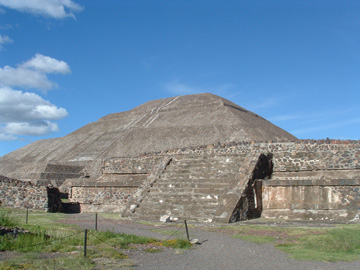Teotihuacan
|
|
Teotihuacán was the largest-known pre-Columbian city in the Americas, and the name is also used to refer to the civilization this city dominated, which at its greatest extent included much of Mesoamerica.
The city was located in what is now the San Juan Teotihuacán municipality (population 44,653 as per 2000 census figures), in the State of México, Mexico, approximately 40 km (about 25 miles) northeast of Mexico City, which covers a total surface area of 82.66 km².
The name is often spelled with an orthographic accent on the last syllable, following the spelling and pronunciation of the name in Spanish. However, the name is pronounced [teoti'wakan] in Nahuatl, with the accent on the syllable wa, and by normal Nahuatl orthographic conventions a written accent would not appear in that position. Both pronunciations are used, and both spellings appear in this article.
The name Teotihuacan was given by the Aztec centuries after the fall of the city, and is translated as "the place where men became gods". But the original name of the city is unknown. Recently the glyph that represents the city has been translated as "The place of the precious sacrifice".
There is archaeological evidence that Teotihuacán had been a multi-ethnic place, with distinct Zapotec, Mixtec, Maya and what seems to be Nahua quarters, for example. The Totonacs have always maintained that they were the ones who built it, a story that was corroborated later by the Aztecs. The city was also anciently referred to as Tollan, a name also used centuries later for the Toltec capital of Tula (Tollan Xicocotitlan in Nahuatl).
History
"Teotihuacán" (teh-oh-tee-wah-kahn) is a Nahuatl name, traditionally translated as "city of the gods," but also translated as "city where men become gods." According to legend it was where the Gods gathered to plan the creation of man.
Construction of Teotihuacán commenced around 300 BC, with the Pyramid of the Sun built by 150 BC. The city reached its zenith approx. 150–450 AD, when it was the center of an influential culture. At its height the city covered over 30 km² (over 11½ square miles), and probably housed a population of over 150,000 people, possibly as many as 200,000. Teotihuacán was an important source of obsidian and there was extensive trade with other regions of Mesoamerica.
The city's broad central avenue, called "Avenue of the Dead" (a translation from its Nahuatl name Miccaohtli), is still flanked by impressive ceremonial architecture, including the immense Pyramid of the Sun (second largest in the New World after the Great Pyramid of Cholula), the Pyramid of the Moon, the Temple of Quetzalcoatl or Temple of the Feathered Serpent, and many lesser temples and palaces.
The Aztec named those pyramids according to their own beliefs, but the "Sun pyramid" was really dedicated to Tlaloc, and was built over a cave, probably considered sacred. Unfortunately the cave content was stolen, possibly in prehispanic times. The Moon pyramid was dedicated to Tlaloc´s consort Chalchihuitlicue and was used also as a burial site for important people.
Unfortunately no ancient Teotihuacano non-ideographic texts are known to exist (or known to have existed), but the city is occasionally referred to in the texts of Maya monuments, showing that Teotihuacán nobility travelled to and married with the families of local rulers as far away as Honduras. Maya hieroglyphs mention an individual nicknamed by scholars as "Spearthrower Owl", apparently Emperor of Teotihuacán, who reigned for over 60 years and imposed his relatives as kings of Tikal and Uaxactun in Guatemala. Most of what we infer about the culture at Teotihuacan comes from the murals that adorn the site and others, like the Wagner Murals, found in private collections.
It was previously believed that sometime during the 7th or 8th centuries, the city was sacked and burned by invaders, possibly the Toltecs. More recent evidence, however, seems to indicate that the burning was limited to the structures and dwellings associated primarily with the elite class. The slums and poorer districts were almost untouched. Many now claim this is evidence that the burning was from an internal uprising and that the invasion theory is flawed due to the fact that early archaeological work on the city was focused exclusively on the palaces and temples, places used by the elites, and because all of these sites showed burning. Archaeologists concluded that the whole city was burned. Instead, it is now known that the destruction in the city was focused on the power symbols: Some statues seem to have been destroyed in a methodical way, their fragments dispersed.
In rebuttal, advocates of the invasion hypothese point to the mural paintings of Cacaxtla, a rival city, in which was found a battle painting featuring the glyph of Teotihuacan over a burning pyramid, the Mesoamerican symbol of a conquered city, which could mean that there really was an attack on Teotihuacan, led by Cacaxtla. However, it was not unknown for ancient rulers to falsely claim victory over foes.
Archaeological site
Knowledge of the huge ruins of Teotihuacan was never lost. The ruined city was a place of pilgrimage in Aztec times, who identified it with the myth of Tollan, the place where the sun was created; it astonished visiting conquistadores, and it has been one of the most noted attractions for visitors to Mexico since the 19th century.
Minor archaeological excavations were conducted in the 19th century, and in 1905 major projects of excavation and restoration began under archaeologist Leopoldo Batres, with the Pyramid of the Sun restored to celebrate the centennial of Mexican Independence in 1910. Teotihuacán remains a major tourist destination, now complete with a museum. Archaeological excavations at the site continue.

